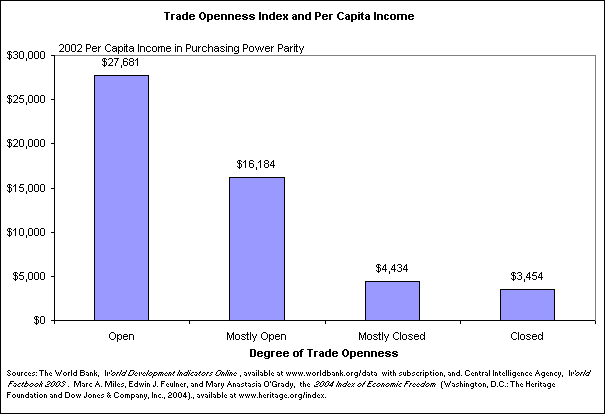You're so full of it.

I said, Read up.
“You need to elaborate a little on your poke at Heritage’s Index of Economic Freedom.”
No problem. For the record, those are the same links Toddster provided me and told me to ‘read up’ so I could learn about ‘freedom’. Well I did, and then I used his own information against him.
‘...Are you suggesting that “free traders” (more precisely, free marketeers) disregard...’
Not at all. I welcome one to regard them as they wish, but do not combine the 10 of them together and then profess others are agains’t freedom if they don’t subscribe to the theories. And yes, much of it is still theory. Downloading and reading through the 2007 Index, it clearly states that both the methedology for the indicators changes yearly, and that they are trying new theories. I don’t want a beta release software package. I can wait for SP2.
Here’s what they Heritage Defines:
“The 10 Economic Freedoms. Overall economic freedom, defined by multiple rights and liberties, can be quantified as an index of less abstract components. The index we conceive uses 10 specific freedoms, some as composites of even further detailed and quantifiable components. A detailed discussion of each of these factors and their component variables follows this overview.
Business freedom is the ability to create, operate, and close an enterprise quickly and easily. Burdensome, redundant regulatory rules are the most harmful barriers to business freedom.
Trade freedom is a composite measure of the absence of tariff and non-tariff barriers that affect imports and exports of goods and services.
Monetary freedom combines a measure of price stability with an assessment of price controls. Both inflation and price controls distort market activity. Price stability without microeconomic intervention is the ideal state for the free market.
Freedom from government is defined to include all government expenditures—including consumption and transfers—and state-owned enterprises. Ideally, the state will provide only true public goods, with an absolute minimum of expenditure.
Fiscal freedom is a measure of the burden of government from the revenue side. It includes both the tax burden in terms of the top tax rate on income (individual and corporate separately) and the overall amount of tax revenue as portion of GDP.
Property rights is an assessment of the ability of individuals to accumulate private property, secured by clear laws that are fully enforced by the state.
Investment freedom is an assessment of the free flow of capital, especially foreign capital.
Financial freedom is a measure of banking security as well as independence from government control. State ownership of banks and other financial institutions such as insurer and capital markets is an inefficient burden, and political favoritism has no place in a free capital market.
Freedom from corruption is based on quantitative data that assess the perception of corruption in the business environment, including levels of governmental legal, judicial, and administrative corruption.
Labor freedom is a composite measure of the ability of workers and businesses to interact without restriction by the state.”
Source:
http://www.heritage.org/research/features/index/chapters/htm/Index2007_Chap3.cfm
Back in 2004, it was appropriately titled “Index of Degrees of Trade-Openness”. The wording changed to make for an easier sell, and now everyone’s scratching their heads trying to figure out what “Freedom” actually means.
“How do you propose shoring-up the dollar with running afoul of Heritage’s categories?”
Did you mean without? Good questions by the way.
“The 10 Economic Freedoms. Overall economic freedom, defined by multiple rights and liberties”
P.S. That should throw a flag up for anyone reading.....
One more important thing: the change of methodology only comes into play if you are comparing results year-to-year, say, the United States' score in 2003 with its score in 2006. That's not the purpose of the Index. It purports to compare countries in a "snapshot" fashion. As long as the method is consistently applied across the group, then there is no problem if the method itself is changed. So, for example, the Index compares the United States with the United Kingdom over the same yearly period.
What's left [pun intended] for a critic of Heritage's methodology is to claim that Heritage is altering its methodology to favor one (or some) countries over others. I've never seen anyone make that argument . . . .
Finally, someone who favors more governmental intervention in the economy is ipso facto less in favor of freedom than another who does not. Benevolent motives don't count.
You're so full of it.

I said, Read up.